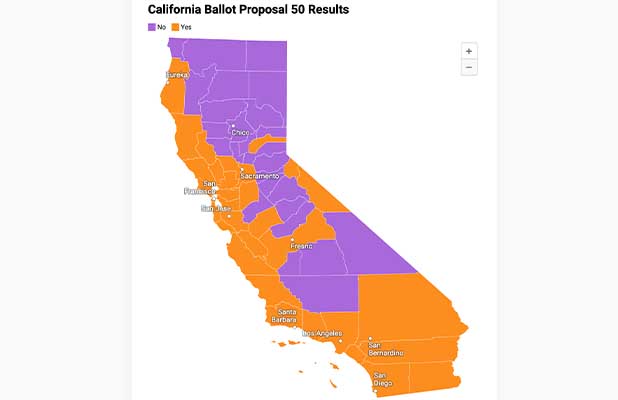
This article provides an in-depth look at California’s Prop 50 and its potential effects on democratic representation. It reflects the student reporter’s thoughtful analysis of how political structures shape power and fairness.- Editor’s Note:
The Origins and Intent of Proposition 50
California’s Proposition 50, passed in the November 4, 2025 special election, represents a significant shift in the state’s congressional redistricting process. Officially a constitutional amendment, Prop 50 temporarily transfers the authority to draw U.S. House district maps from the independent California Citizens Redistricting Commission (CCRC) to the state Legislature. The new legislative maps will apply to the 2026, 2028, and 2030 elections, after which the independent commission will resume its traditional role following the 2030 census. Beyond California, the measure also contains a non-binding request for Congress to adopt nationwide standards for non-partisan redistricting, underscoring its broader political relevance.

The origins of Prop 50 can be traced to decades of reform aimed at limiting partisan gerrymandering in California. Before the creation of the CCRC, the state Legislature controlled both congressional and state legislative redistricting. This system often resulted in districts drawn to favor incumbents and the majority party, prompting public outcry over fairness and representation. In 2008, voters passed Proposition 11 and, in 2010, Proposition 20, which established the independent commission for state legislative and congressional districts. The commission’s mandate was to produce maps based on neutral criteria, including the preservation of “communities of interest,” geographic compactness, and compliance with the Voting Rights Act. For many, the commission represented a historic step toward creating fairer representation in one of the nation’s most populous and diverse states.
Political Context and Controversy
Prop 50 represents a temporary departure from that model. Supporters framed it as a defensive measure, designed to counteract partisan redistricting strategies employed in other states. For example, Republican-controlled states such as Texas have redrawn congressional maps mid-cycle to favor their party, influencing federal elections in ways that often conflict with proportional representation. California Democrats argued that similar tactics could threaten the state’s congressional influence if the independent commission were required to adhere strictly to its current rules. By passing Prop 50, proponents sought to ensure that California’s congressional delegation remained competitive and reflective of the state’s interests on the national stage. Governor Gavin Newsom and the Democratic-majority Legislature promoted the measure as a safeguard for the U.S. House majority, emphasizing the national implications of California’s congressional maps.
Under Prop 50, the Legislature gains authority to draw the state’s 52 congressional districts for the 2026–2030 period. These legislative maps must comply with federal law, including the Voting Rights Act and the principle of “one person, one vote,” but they are not bound by certain state-specific rules followed by the independent commission. Notably, lawmakers are not required to prioritize preserving communities of interest or limiting the splitting of cities and counties. Critics argue this creates an opening for partisan gerrymandering, as elected officials could design maps that favor their own party, reduce minority voting power, or consolidate safe districts at the expense of fair competition. Supporters, however, contend that this temporary shift allows California to respond strategically to national political pressures without permanently undermining independent redistricting.

The campaign surrounding Prop 50 was among the most expensive in California’s history. Supporters invested tens of millions of dollars in television and digital ads, mailers, and other outreach efforts. They framed the proposition as a measure to defend democracy against partisan manipulation elsewhere and protect California’s congressional influence nationally. Opponents characterized the measure as a blatant “power grab” that prioritized partisan advantage over fairness, warning that legislative control could entrench the Democratic majority and erode safeguards designed to protect minority communities. The contentious nature of the debate highlighted the broader tensions in U.S. politics, where structural rules, rather than voter preferences alone, can determine the balance of power.
Consequences and Broader Implications
On election day, voters approved Prop 50, with early estimates suggesting roughly 64% support. The passage of the proposition has immediate and long-term implications for California’s political landscape. In the short term, the Legislature now controls congressional redistricting for three election cycles, potentially altering the partisan composition of California’s House delegation. Analysts have suggested that these legislative maps could result in several additional Democratic-held seats, impacting the national balance of power in the U.S. House. The passage also sets a precedent for using structural reforms selectively, raising questions about whether other states might adopt similar measures to consolidate political advantage.
Legal challenges quickly followed. California Republicans and advocacy groups filed lawsuits claiming that the legislative maps violate constitutional principles and unfairly favor certain communities. These legal disputes are likely to play out over the next several years, determining whether the maps will stand as drawn or require adjustment. Beyond the courtroom, Prop 50 prompts broader reflection on the interplay between institutional rules, political strategy, and representative democracy. Redistricting is not merely a technical exercise; it determines which communities are grouped together, whose voices are amplified, and whose influence is diluted. By temporarily returning map-drawing authority to the Legislature, Prop 50 raises important questions about fairness, accountability, and the power dynamics embedded within democratic institutions.
 In addition to its immediate political effects, Prop 50 offers a valuable case study in the broader national struggle over redistricting. It illustrates how structural rules like maps, commissions, and legislation can be manipulated to achieve strategic objectives, often with consequences that extend beyond state boundaries. For students, policymakers, and analysts, the measure underscores the importance of understanding not just who votes, but how the rules governing elections shape the outcomes of those votes. California, as the nation’s most populous and diverse state, provides a particularly striking example of how redistricting decisions can influence representation, policy, and political power at multiple levels.
In addition to its immediate political effects, Prop 50 offers a valuable case study in the broader national struggle over redistricting. It illustrates how structural rules like maps, commissions, and legislation can be manipulated to achieve strategic objectives, often with consequences that extend beyond state boundaries. For students, policymakers, and analysts, the measure underscores the importance of understanding not just who votes, but how the rules governing elections shape the outcomes of those votes. California, as the nation’s most populous and diverse state, provides a particularly striking example of how redistricting decisions can influence representation, policy, and political power at multiple levels.
In conclusion, California’s Proposition 50 is far more than a procedural ballot measure. It is a reflection of the ongoing national debate over political power, representation, and fairness in democracy. By temporarily transferring redistricting authority to the Legislature, the proposition affects congressional representation, partisan balance, and legal precedent, while prompting broader discussions about accountability and institutional integrity. Its passage demonstrates how political actors can leverage structural mechanisms to achieve strategic ends, and it serves as a reminder that democracy depends not only on elections themselves but also on the rules that define how those elections are conducted. As California implements Prop 50, the measure will continue to shape political discourse and offer lessons about the delicate balance between fair representation and strategic political maneuvering.
<Esther Hong Student Reporter> LACES ehong0006@mymail.lausd.net






